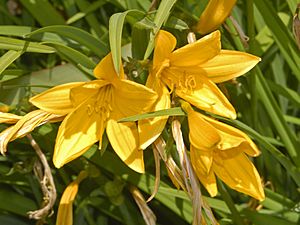Hemerocallis citrina facts for kids
Quick facts for kids Hemerocallis citrina |
|
|---|---|
 |
|
| At the Jardin des Plantes, Paris | |
| Scientific classification |
The Citron Daylily (its scientific name is Hemerocallis citrina) is a beautiful plant often called the Long Yellow Daylily. It's a type of perennial plant, which means it lives for more than two years and comes back each growing season. This plant belongs to the family called Asphodelaceae.
Contents
What Does the Citron Daylily Look Like?
The Citron Daylily can grow quite tall, usually reaching about 90 to 120 centimeters (about 3 to 4 feet) high. It has bright green leaves that are long and narrow, like blades, and they arch gracefully. These leaves are about 40 centimeters (16 inches) long.
The flowers are the most striking part! They are a lovely lemon yellow color and shaped like trumpets. They are very showy and have a wonderful, strong smell. Each flower is about 15 centimeters (6 inches) wide. You can see these beautiful flowers blooming from June to July. In some parts of Asia, people even grow this daylily specifically for its edible flowers.
Where Does the Citron Daylily Grow?
This plant originally comes from East Asia, especially China. You can find it growing in different natural places. It likes to live at the edges of forests, in open grassy fields, and on hillsides. It can grow from sea level all the way up to 2,000 meters (about 6,500 feet) high in the mountains.
How People Use Citron Daylily
Many parts of the Citron Daylily can be cooked and eaten! This includes its underground tubers (like small potatoes), its flower stalks, the unopened flower buds, and the fully bloomed flowers.
Dried or fresh flowers of the Citron Daylily are often used in Chinese cooking. They are sometimes called "gum jum" or "golden needles." In Chinese, they are known as jīn zhēn (金針) or huánghuācài (黃花菜), which means "yellow flower vegetable." These flowers add a unique flavor and texture to many dishes. Some popular Chinese dishes that use them include hot and sour soup, daylily soup (金針花湯), Buddha's delight, and moo shu pork.
See also
 In Spanish: Hemerocallis citrina para niños
In Spanish: Hemerocallis citrina para niños

